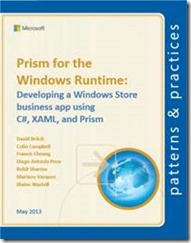Developing a Windows Store Business App using C#, XAML, and Prism
About patterns & practices
The Microsoft patterns & practices team is responsible for delivering applied engineering guidance that helps Software architects, developers, and their teams take full advantage of Microsoft’s platform technologies in their application development project.
They have a simple goal of helping software development teams be more successful with the Microsoft application platform.
They do this by delivering guidance that:
− Helps to simplify the Microsoft application platform.
− Provides solution guidance to common problems.
− Helps development teams grow their skills and learn.
For more information: https://www.microsoft.com/practices
Guidance on how to create a Windows Store business app using C#, XAML and the Prism library.
Ever wanted to know how to start building Windows Store Business app take a look at the AdventureWorks Shopper reference implementation and the Prism for Windows Runtime library.
The AdventureWorks Shopper reference implementation uses the Prism library to demonstrate modern development practices such as the Model-View-ViewModel (MVVM) pattern with navigation and app lifecycle management. Additionally the reference implementation demonstrates validation, application data management, accessibility, localizability, touch, search, tiles, tile notification, and multiple view states. It also provides guidance on testing your app and tuning its performance.
Similar to the Prism library for WPF and Silverlight or “Prism Classic,” Prism for Windows Runtime makes it easier to design and build flexible and easy-to-maintain Windows Store business apps using modern development practices.
These apps are “built to last” and “built to change.” They use design patterns that embody important architectural design principles, such as separation of concerns and loose coupling.
What’s in the Box?
─ Reference Implementation (RI) – the Adventure Works ShopperRI demonstrates validation, application data management, accessibility, localizability, touch, search, tiles, and tile notification.
─ Quickstarts:
Hello World – demonstrates how to create a Hello World app for the Windows Store using the Prism library. Event Aggregator – demonstrates how to send loosely coupled messages between components.Validation – demonstrates how to validate data on forms in a Windows Store app.
─ Prism library
Model-View-ViewModel (MVVM) with app lifecycle management and navigation
Event Aggregator in a Portable Class Library
Validation
Delegate Command
Flyout, Search, and Settings
─ Guide – “Developing a Windows Store business app using C#, XAML, and Prism for the Windows Runtime” is designed to help developers create Windows Store business apps using the Prism library.
How to Get It?
The Prism library source code is available with the AdventureWorks Shopper reference implementation on the MSDN Code Gallery at https://aka.ms/prism-winrt-code. The Prism binaries are available on NuGet. Search for prism.storeapps and prism.pubsubevents.
You can view the documentation at https://aka.ms/prism-winrt-doc or download a PDF version at https://aka.ms/prism-winrt-pdf.


